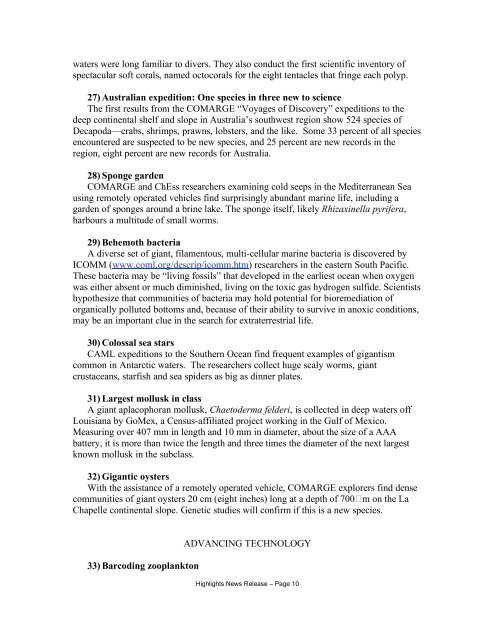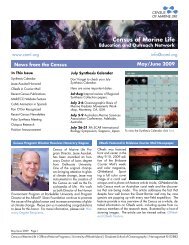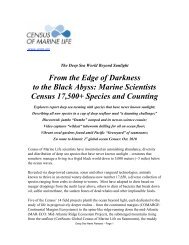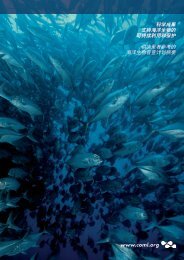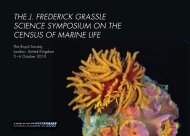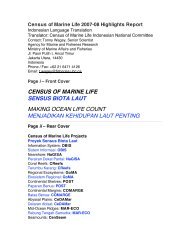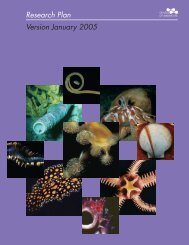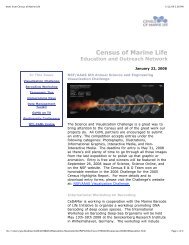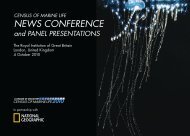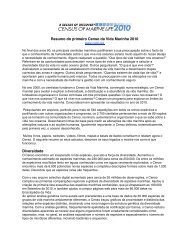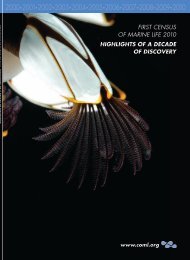Full press release - Census of Marine Life
Full press release - Census of Marine Life
Full press release - Census of Marine Life
You also want an ePaper? Increase the reach of your titles
YUMPU automatically turns print PDFs into web optimized ePapers that Google loves.
waters were long familiar to divers. They also conduct the first scientific inventory <strong>of</strong>spectacular s<strong>of</strong>t corals, named octocorals for the eight tentacles that fringe each polyp.27) Australian expedition: One species in three new to scienceThe first results from the COMARGE “Voyages <strong>of</strong> Discovery” expeditions to thedeep continental shelf and slope in Australia’s southwest region show 524 species <strong>of</strong>Decapoda—crabs, shrimps, prawns, lobsters, and the like. Some 33 percent <strong>of</strong> all speciesencountered are suspected to be new species, and 25 percent are new records in theregion, eight percent are new records for Australia.28) Sponge gardenCOMARGE and ChEss researchers examining cold seeps in the Mediterranean Seausing remotely operated vehicles find surprisingly abundant marine life, including agarden <strong>of</strong> sponges around a brine lake. The sponge itself, likely Rhizaxinella pyrifera,harbours a multitude <strong>of</strong> small worms.29) Behemoth bacteriaA diverse set <strong>of</strong> giant, filamentous, multi-cellular marine bacteria is discovered byICOMM (www.coml.org/descrip/icomm.htm) researchers in the eastern South Pacific.These bacteria may be “living fossils” that developed in the earliest ocean when oxygenwas either absent or much diminished, living on the toxic gas hydrogen sulfide. Scientistshypothesize that communities <strong>of</strong> bacteria may hold potential for bioremediation <strong>of</strong>organically polluted bottoms and, because <strong>of</strong> their ability to survive in anoxic conditions,may be an important clue in the search for extraterrestrial life.30) Colossal sea starsCAML expeditions to the Southern Ocean find frequent examples <strong>of</strong> gigantismcommon in Antarctic waters. The researchers collect huge scaly worms, giantcrustaceans, starfish and sea spiders as big as dinner plates.31) Largest mollusk in classA giant aplacophoran mollusk, Chaetoderma felderi, is collected in deep waters <strong>of</strong>fLouisiana by GoMex, a <strong>Census</strong>-affiliated project working in the Gulf <strong>of</strong> Mexico.Measuring over 407 mm in length and 10 mm in diameter, about the size <strong>of</strong> a AAAbattery, it is more than twice the length and three times the diameter <strong>of</strong> the next largestknown mollusk in the subclass.32) Gigantic oystersWith the assistance <strong>of</strong> a remotely operated vehicle, COMARGE explorers find densecommunities <strong>of</strong> giant oysters 20 cm (eight inches) long at a depth <strong>of</strong> 700 m on the LaChapelle continental slope. Genetic studies will confirm if this is a new species.33) Barcoding zooplanktonADVANCING TECHNOLOGYHighlights News Release – Page 10


